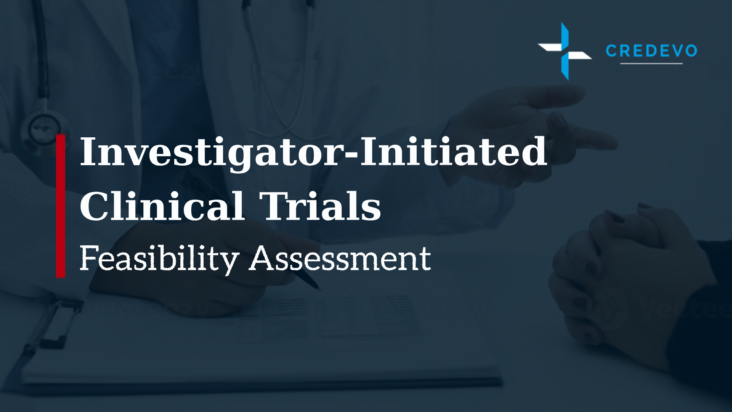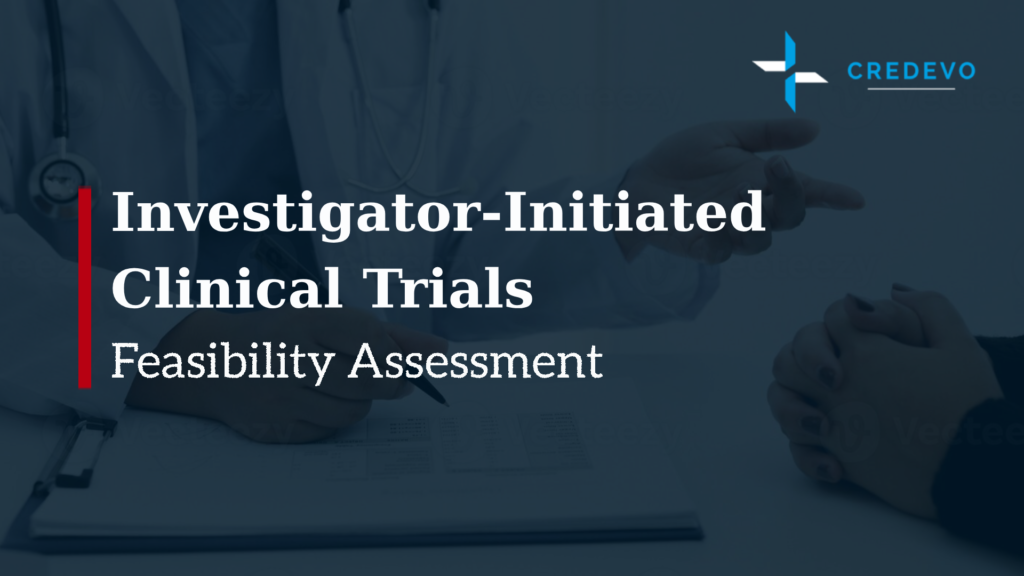Exploring Investigator-Initiated Clinical Trials (IITs) & Assessing Feasibility

Executing an IIT is often more complex for various reasons, including the necessity for industry support. Therefore, conducting an early feasibility assessment/evaluation before commencing an IIT can help address most challenges. Investigator-initiated trials (IITs) are typically conducted at academic hospitals and universities, distinguishing them from regular clinical trials in several aspects.

What are Investigator-Initiated Trials (IITs)?
Investigator-initiated studies are ideas developed by researchers and investigators in laboratories and clinics. The trial’s sponsor investigator is both sponsoring and conducting the study. They will be in charge of developing, coordinating, and implementing the IIT. This can be done alone or with a team assisting the sponsor investigator.
There are multiple terms for the studies undertaken by investigators like
- IIT – Investigator-initiated Initiated Trials
- IIR – Investigator-Initiated Research
- PIT – Physician Initiated Trials
- IST – Investigator Sponsored Trial
- IIS – Investigator-Initiated Studies
- ISR – Investigator Sponsored Research
- ISS – Investigator Sponsored Study
- ERP – External Research Programs
- Independent studies
The key advantages of IIT over company-sponsored studies are listed below:
- A successful IIT offers various advantages over a traditional clinical trial, frequently filling gaps left by unsolved issues from a previous trial.
- IITs allow investigating the usage of commercial medications for new indications, in subsections of approved populations, and innovative combinations with existing treatments.
- IITs can help to develop new diagnostic tools and methods.
- Provide clinical data to pharmaceutical companies to better understand their products in the real world.
Principal roles in an Investigator-Initiated Trial
An investigator-initiated trial has three key roles: the sponsor investigator, the investigator, and the sponsor.
The detailed responsibilities for each role are listed in the table below.
| IIT Sponsor Investigator | IIT Sponsor | IIT Investigator |
|---|---|---|
| Accountable for all sponsorship and regulatory requirements, including funding | Ensure human subjects’ safety | Maintains patient records and controls the therapies/drugs being investigated |
| Conceive and create the study framework | Selection of qualified investigators | Monitors compliance with the study’s protocols and investigative plan |
| Coordinate the study | Monitor the progress of the study | Submits various documents including progress reports, safety reports, and financial disclosures |
| Conduct the study | Documentation of the study | Responsible for obtaining informed consent from subjects |
What are the differences between Sponsor-Initiated Trials and Investigator-Initiated Trials
The following are some key differences between sponsor-initiated clinical trials and investigator-initiated trials:
| Category | Sponsor-Initiated Trials | Investigator-Initiated Trials |
|---|---|---|
| Data | The sponsor owns CRFs and reports that the sponsor provides; the Institution owns medical records and other data | The university owns the protocol, documents, research results, and data |
| Funding | Sponsor | Grants; Industry Funding; University; Department |
| IND/IDE Holder | Sponsor | Investigator |
| Intellectual Property | The sponsor owns patentable inventions conceived and reduced to practice; the institution owns everything else. | The university owns all inventions and intellectual property |
| Injuries and Indemnifications | The sponsor pays unless non-compliance, negligence, or misconduct on the part of the PI or the institution causes the damage | No compensation for injuries is provided |
| Protocol Author | Sponsor | Investigator |
| Study type | Often investigates a new drug’s or medical product’s efficacy | Mostly comparative studies |
| Timelines | Stringent timelines | Timelines may be extended due to delays in grant and regulatory applications |
Common challenges encountered in Investigator-Initiated Clinical Trials
The following are some challenges that arise when conducting an investigator-initiated trial:
- Inadequate internal support means that a multidisciplinary team of experts, including project managers, biostatisticians, data managers, pharmacists, and monitors, is needed. Thus, costs are increased significantly.
- Lack of experience with the basic concepts behind clinical trials and their consequences, including safety monitoring, protocol and study design, study commencement and monitoring, ethical and legal issues, and data management.
- Financial limitations because conducting a trial involves expenses for study equipment, lab testing, logistics, personnel, and other ancillary expenses.
An early feasibility assessment – A better option to overcome Investigator-Initiated Trial (IIT) challenges
To generate a good IIT, investigators have to learn how to produce scientific value and establish robust guidelines to guide the study. Their network and economic limitations will force them to focus on upholding a strict efficiency standard.
Considering the various challenges that result from the investigator’s inexperience in this area, it is best to approach IIT planning as a learning exercise.
The investigator must possess advanced competence in multiple fields to initiate an IIT. An early feasibility assessment can assist in addressing the majority of the following obstacles like below:
1. Study duration
Determining the overall time needed for clinical trial approval, certain regulatory requirements that can affect study site decisions, etc., is the aim of the study’s feasibility.
2. Epidemiology of the desired indication
Incidence and prevalence of indication, disease-specific patient population, classification of existing treatment regimens or guidelines, and accessibility to alternative drugs and therapies.
3. Investigator feasibility
Evaluations of the investigator’s expertise about standard care (drug type, dosage, etc.), the real study population in contrast to the patient population treated or experienced by the potential investigator, and the investigator’s expertise with technology and tools are all part of the investigator-level feasibility assessment.
4. Site feasibility
Demographics about the site help to determine the nature of clinical practice (hospital versus outpatient), prior clinical trial experience, and the presence of study coordinators, pharmacists, and nurses.
This helps to determine the investigator’s or site’s “competency” in conducting the clinical trial, but not so much in terms of medical expertise as in protocol-related knowledge, personnel availability, etc.
Click here to learn more about the clinical trial feasibility: why and how to conduct them.
5. Patient Recruitment And Retention
The most important element of the site feasibility is the part that centers on recruiting and retention. It is particularly useful in assessing the potential for recruitment in terms of predicted participants each month and across the trial.
It aids in choosing whether we want to research more sites and evaluate site performance while a study is ongoing.
The additional information covered ethical concerns, comparative studies, previous experience doing analogous investigations, and more.
6. Infrastructure of the site
The most important element of the site feasibility is the part that centers on recruiting and retention. It is particularly useful in assessing the potential for recruitment in terms of predicted participants each month and across the trial.
It aids in choosing whether we want to research more sites and evaluate site performance while a study is ongoing.
The additional information covered ethical concerns, comparative studies, previous experience doing analogous investigations, and more.
7. Quality:
Another factor to examine is whether a site has undertaken sponsor or independent site audits previously. Second, the FDA, EMA, and a few other regulatory authorities have conducted site inspections in recent years.
It could be an excellent strategy to find out if the site has suffered any of these and, if so, what difficulties have been raised. During the launch phase, this helps teams allocate appropriate resources and provide adequate training.
Conclusion
Traditional clinical trials profit from the abundance of industrial capital and knowledge. Because investigator-initiated trials lack these qualities, investigators must plan and execute their investigations with stricter discipline and greater efficiency.
An IIS runs the risk of collapsing in these constraints. A smaller team, a lower budget, or a lack of experience may cause a study’s failure. However, when implemented properly, an IIT can solve a great deal of the clinical problems that doctors encounter in the real world. As a result, they are a crucial ability for a committed investigator to build up.
Do you need any further information or have any questions about Investigator-Initiated Clinical Trials (IITs)?
Are you unsure about how to proceed with this IIT or are you considering conducting a feasibility assessment for a go/no-go decision? Feel free to provide your questions, doubts, or queries by filling out the form below to connect with our expert team.